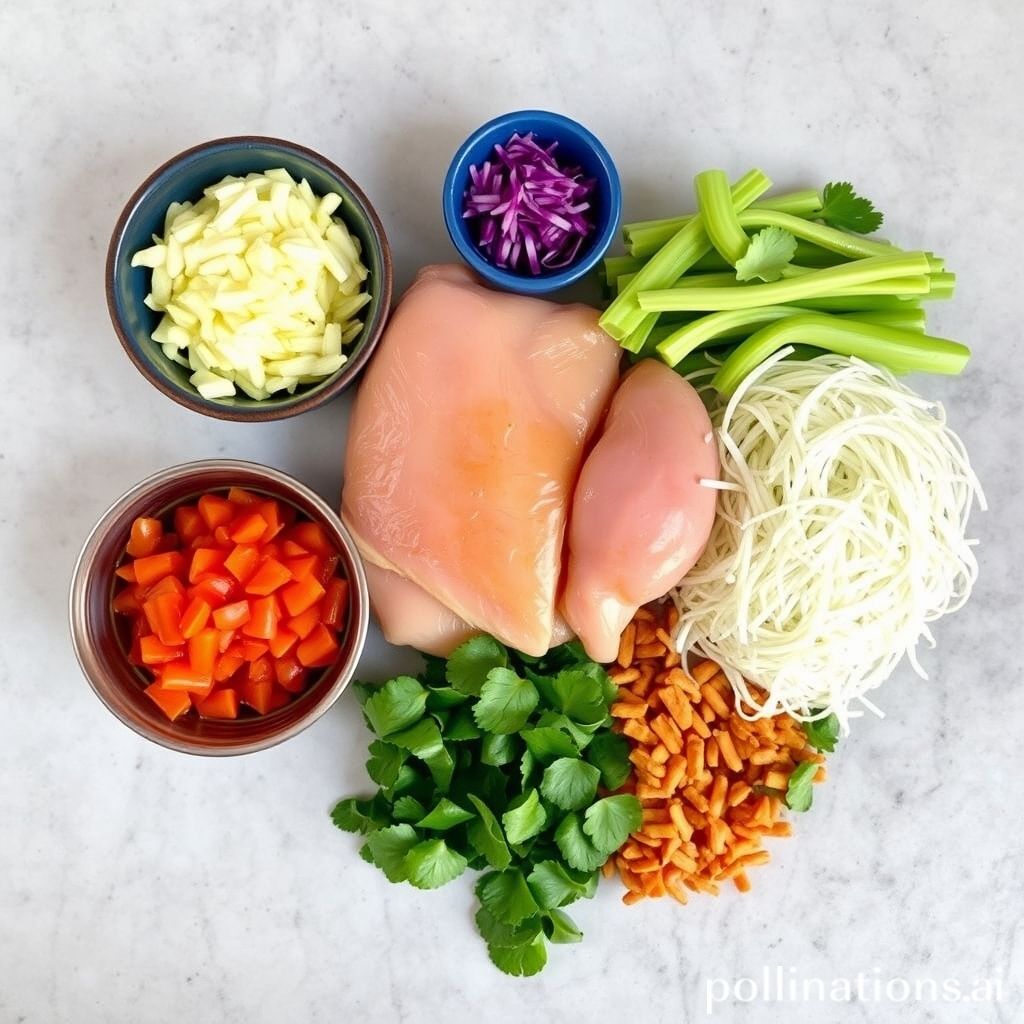Table of Contents
- Introduction
- Ingredients required for Thai Red Curry Chicken
- Step-by-step preparation method
- Tips for perfecting the curry
- Nutritional benefits and facts
- Variations to try
- Serving suggestions and accompaniments
- How to store and reheat leftovers
- Common mistakes to avoid
- Conclusion
- Frequently Asked Questions
Introduction
Imagine the rich aroma of coconut milk mingling with the fiery zest of red chilies, as tender chicken pieces soak up these vibrant flavors. Welcome to the tantalizing world of Thai Red Curry Chicken, a dish that represents the heart and soul of Thai cuisine. This culinary journey embarks with an exquisite blend of ingredients, each playing a pivotal role in creating a symphony of taste and texture.
Here’s what you need to get started:
- 500g of chicken breast, sliced
- 2 tablespoons of red curry paste
- 1 can of coconut milk (400ml)
- 1 cup of chicken stock
- 2 tablespoons of fish sauce
- 1 tablespoon of palm sugar
- 2 bell peppers, thinly sliced
- 1 cup of bamboo shoots
- Fresh basil leaves for garnish
In this article, we’ll delve deep into the essence of what makes Thai Red Curry Chicken not only a dinner favorite but also a gateway to understanding the intricate balance of flavors that Thai cuisine offers. From the historical origins to the cooking techniques that elevate every ingredient, get ready to savor the spice in its most authentic form.
Ingredients required for Thai Red Curry Chicken
To make a delicious Thai Red Curry Chicken, you will need a variety of fresh and aromatic ingredients. The core ingredient is chicken, typically boneless and skinless chicken breasts or thighs, cut into bite-sized pieces. The soul of the dish is the Thai red curry paste, which infuses the curry with its characteristic flavors.
Coconut milk is essential as it provides the creamy base for the curry. Vegetables such as bell peppers, bamboo shoots, and zucchini add texture and nutritional value. Fresh herbs like Thai basil and cilantro enhance the dish with their fragrant aroma.
Other key ingredients include fish sauce, which adds a salty umami flavor, and brown sugar to balance the spiciness with sweetness. Garlic and onions are often used to build the foundational flavors, while kaffir lime leaves give a unique citrusy note.
For a touch of heat, you may want to include fresh or dried red chilies. Finally, serve the curry with jasmine rice or rice noodles for a complete and satisfying meal. With these ingredients, you can create an authentic and flavorful Thai Red Curry Chicken that will tantalize your taste buds.
Step-by-step preparation method
Preparing Thai Red Curry Chicken is a delightful culinary journey. Start by gathering all your ingredients: boneless chicken breast, red curry paste, coconut milk, vegetables (such as bell peppers, bamboo shoots, and carrots), fish sauce, and fresh basil leaves. Begin by heating a tablespoon of oil in a large pan or wok over medium heat. Add the red curry paste and stir-fry for a couple of minutes to release its aromatic flavors. Next, add the chicken pieces and cook until they are no longer pink, ensuring they are well-coated with the curry paste. Pour in the coconut milk, stirring consistently to blend it with the paste. Bring the mixture to a gentle simmer.
Add the vegetables to the pan, allowing them to cook until they reach your desired level of tenderness, typically about 5-7 minutes. Stir in a dash of fish sauce to enhance the umami flavor. Simmer the curry for a few more minutes to let the flavors meld together beautifully. Finally, sprinkle fresh basil leaves over the top and give it a quick stir before removing the pan from the heat. Serve your Thai Red Curry Chicken hot with jasmine rice or noodles for an authentic Thai experience.
Tips for perfecting the curry
To master the art of Thai Red Curry Chicken, a few essential tips can make all the difference. First and foremost, use fresh ingredients whenever possible. Fresh herbs like Thai basil, cilantro, and lemongrass will elevate the flavors significantly. Quality coconut milk is another critical component; opt for a good brand that offers a creamy texture.
Balancing flavors is key in Thai cuisine. Pay attention to the harmony of salty, sweet, sour, and spicy elements. Fish sauce, sugar, tamarind paste, and chili peppers are your best friends in achieving this balance. Don’t be afraid to adjust the quantities to suit your taste.
Sautéing the curry paste is an often overlooked but crucial step. Frying the paste in a bit of oil before adding other ingredients releases its aromatic qualities and intensifies the flavor. Allow the paste to cook until it becomes fragrant, usually around 2-3 minutes.
Lastly, cook your chicken just right. Whether you’re using chicken breast or thighs, make sure not to overcook it, as this can make the meat tough. Add it towards the end of your cooking process to keep it tender and juicy.
Nutritional benefits and facts
Thai Red Curry Chicken is not only a flavorful and aromatic dish but also comes with a variety of nutritional benefits. This dish typically includes chicken, which is a great source of lean protein, essential for muscle growth and repair. Depending on the recipe, vegetables such as bell peppers, bamboo shoots, and zucchini may be added, contributing vitamins and minerals like vitamin A, vitamin C, and potassium.
The red curry paste, made from red chilies, garlic, lemongrass, and other herbs, offers antioxidants and anti-inflammatory properties. Coconut milk, a staple in Thai curry, is rich in medium-chain triglycerides (MCTs), which can provide quick energy and support brain function. However, it’s important to note that coconut milk is high in saturated fats, so moderation is key.
Another notable ingredient is ginger, known for its digestive benefits and ability to reduce nausea. Fish sauce and lime juice add depth to the dish while providing a source of essential minerals. While Thai Red Curry Chicken can be high in calories and fats, especially from the coconut milk, its rich nutrient profile can make it a worthwhile addition to a balanced diet when enjoyed in moderation.
Variations to try
Thai Red Curry Chicken is a versatile dish that can be customized in numerous ways to suit your taste preferences. One popular variation is to substitute the chicken with shrimp or tofu for a different protein option. This substitution can add a unique flavor profile and cater to dietary restrictions.
Another variation involves adding a variety of vegetables such as bell peppers, bamboo shoots, or baby corn. These additions not only enhance the nutritional value but also provide a delightful texture contrast to the creamy curry. For those who enjoy a bit of sweetness, incorporating pineapple chunks can offer a refreshing twist.
For spice enthusiasts, increasing the amount of red curry paste or adding fresh chilies can elevate the heat level. Additionally, experimenting with different herbs like Thai basil or cilantro can introduce new aromatic elements to the dish.
Some variations also include the use of different types of curry paste, such as massaman or green curry, to create a fusion of flavors. Finally, serving the curry with a variety of accompaniments such as jasmine rice, noodles, or even roti can provide a diverse dining experience. The possibilities are endless, making Thai Red Curry Chicken an adaptable and exciting dish to explore.
Serving suggestions and accompaniments
Thai Red Curry Chicken is a delectable dish that can be enjoyed in various ways. To enhance the dining experience, it is important to consider the right serving suggestions and accompaniments. Traditionally, Thai Red Curry Chicken is best served with steamed jasmine rice. The fragrant rice helps to balance the rich and creamy curry sauce, providing a perfect base that absorbs the flavors. For a healthier alternative, you can opt for brown rice or quinoa.
If you are looking to add some texture and variety, serve the curry with a side of fresh vegetables such as steamed broccoli, carrots, or snap peas. These not only add a burst of color to your meal but also complement the curry’s robust flavors. For a more authentic Thai experience, consider serving the curry with a side of Thai cucumber salad or a plate of fresh herbs like cilantro and Thai basil.
Additionally, crispy prawn crackers make for a delightful accompaniment, offering a crunchy contrast to the creamy curry. To elevate the meal further, pair it with a refreshing beverage like Thai iced tea or coconut water. These suggestions will help you create a well-rounded and satisfying dining experience.
How to store and reheat leftovers
Storing and reheating Thai Red Curry Chicken leftovers is straightforward, ensuring you preserve the rich flavors and textures. First, allow the curry to cool to room temperature before transferring it to an airtight container. Properly sealed, the curry can be stored in the refrigerator for up to 3-4 days. For longer storage, consider freezing the curry. Place it in a freezer-safe container or heavy-duty freezer bag, and it can last up to 2-3 months.
When reheating leftovers, you have a few options. For the stove method, pour the curry into a saucepan and heat over medium heat, stirring occasionally until it is thoroughly warmed. If the curry thickens too much, add a splash of coconut milk or water to achieve the desired consistency. To use a microwave, transfer a portion of the curry to a microwave-safe dish and cover it with a microwave-safe lid or microwave-safe plastic wrap. Heat on medium power in 1-2 minute intervals, stirring in between, until evenly heated. Whether you use a stove or microwave, ensure the curry is heated to an internal temperature of 165°F (74°C) for safe consumption.
Common mistakes to avoid
When preparing Thai Red Curry Chicken, it’s important to avoid some common mistakes to ensure you get the best flavors and textures. First, avoid using low-quality coconut milk; a rich and creamy coconut milk is crucial for achieving the curry’s authentic taste. Cheap, watery varieties can dilute the flavor and texture.
Another mistake is not properly cooking the curry paste. To develop deep, robust flavors, fry the curry paste in oil for a few minutes before adding other ingredients. This step allows the spices to release their full aroma.
Using pre-cooked or leftover chicken can also be detrimental to the dish. For the juiciest and most flavorful results, always use fresh chicken and toss it into the curry raw. This allows the meat to absorb the rich flavors of the sauce as it cooks.
Additionally, avoid overloading your curry with too many vegetables. While it’s tempting to add a variety of veggies, sticking to a select few like bell peppers, bamboo shoots, and Thai basil will keep the dish balanced.
Lastly, don’t skip the step of tasting your curry before serving. Adjusting the balance of sweet, salty, spicy, and sour is key to achieving that perfect, harmonious flavor that Thai cuisine is famous for.
Conclusion
Diving into the world of Thai Red Curry Chicken offers a rich culinary experience that not only tantalizes the taste buds but also provides numerous nutritional benefits. From gathering fresh, aromatic ingredients to mastering the step-by-step preparation, each aspect of this dish contributes to its authentic and irresistible flavors. Whether you’re exploring new variations, seeking tips for perfecting your curry, or looking for the ideal accompaniments, this guide has you covered.
Embrace the vibrant and flavorful world of Thai cuisine and take your cooking skills to the next level. Why stop at Thai Red Curry Chicken? Expand your culinary repertoire with endless chicken recipes by getting The Chicken Bible: Say Goodbye to Boring Chicken with 500 Recipes for Easy Dinners, Braises, Wings, Stir-Fries, and So Much More. Don’t miss out—transform your meals and delight your family with this must-have book. Purchase your copy today!

